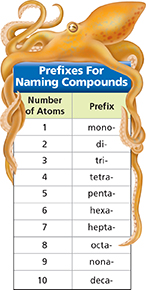Two compounds that contain nitrogen and oxygen have the formulas N2O4 and NO2. The names of these two compounds reflect the actual number of atoms of nitrogen and oxygen in a molecule of each compound. You can use the Greek prefixes in Figure 20 to describe the number of nitrogen and oxygen atoms in each molecule.
In an N2O4 molecule, there are two nitrogen atoms and four oxygen atoms. The Greek prefixes for two and four are di-and tetra-. The name for the compound with the formula N2O4 is dinitrogen tetraoxide. In an NO2 molecule, there are one nitrogen atom and two oxygen atoms. The Greek prefixes for one and two are mono- and di-. So a name for the compound with the formula NO2 is mononitrogen dioxide. However, the prefix mono-often is not used for the first element in the name. A more common name for the compound with the formula NO2 is nitrogen dioxide.
Writing Molecular Formulas
Writing the formula for a molecular compound is easy. Write the symbols for the elements in the order the elements appear in the name. The prefixes indicate the number of atoms of each element in the molecule. The prefixes appear as subscripts in the formulas. If there is no prefix for an element in the name, there is only one atom of that element in the molecule.
What is the formula for diphosphorus tetrafluoride? Because the compound is molecular, look for elements on the right side of the periodic table. Phosphorus has the symbol P. Fluorine has the symbol F. Di-indicates two phosphorus atoms and tetra-indicates four fluorine atoms. The formula for the compound is P2F4.
Figure 20 These Greek prefixes are used to name molecular compounds. The prefix octa-means “eight,” as in the eight tentacles of an octopus.
 d
dSection 6.3 Assessment
Reviewing Concepts
 What does the formula of an ionic compound describe?
What does the formula of an ionic compound describe? What do the name and formula of a molecular compound describe?
What do the name and formula of a molecular compound describe?What suffix is used to indicate an anion?
Why are Roman numerals used in the names of compounds that contain transition metals?
What is a polyatomic ion?
Critical Thinking
Applying Concepts How is it possible for two different ionic compounds to contain the same elements?
Calculating How many potassium ions are needed to bond with a phosphate ion?
Math Practice
What are the names of these ionic compounds: LiCl, BaO, Na3N, and PbSO4?
Name the molecular compounds with these formulas: P2O5 and CO.
What is the formula for the ionic compound formed from potassium and sulfur?




